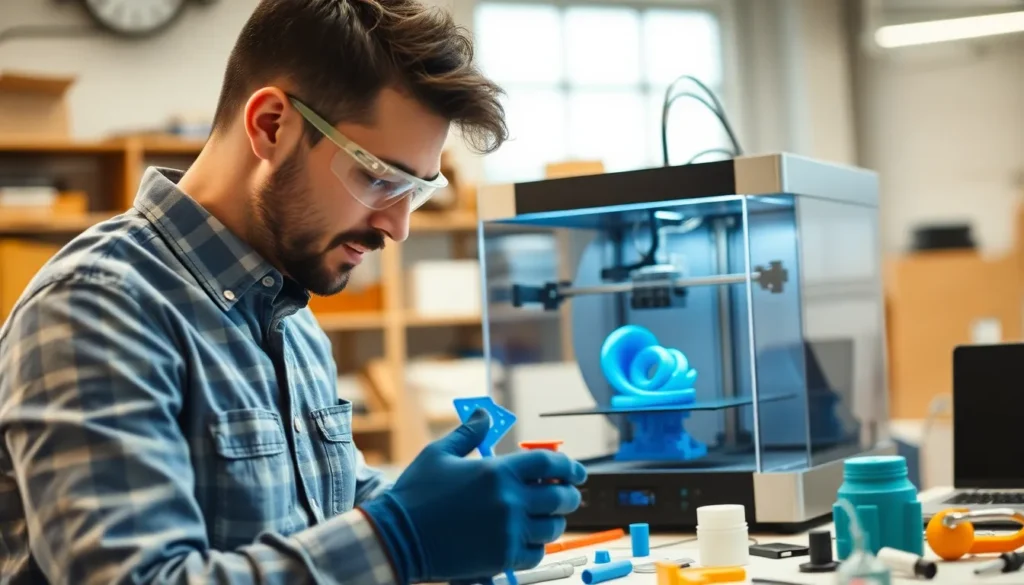Table of Contents
ToggleImagine stepping into a convention and instantly turning heads with your jaw-dropping cosplay. Thanks to 3D printing, that dream can become a reality faster than you can say “Kamehameha!” Gone are the days of painstakingly crafting every detail by hand. With a 3D printer, even the most intricate designs can be whipped up in no time, leaving you more time for what really matters: perfecting your pose for those Instagram photos.
Overview of 3D Printing for Cosplay
3D printing revolutionizes the cosplay landscape by enabling creators to produce intricate designs and components with precision. Costumes that once took weeks or months to craft can now come to life in a matter of days. Enthusiasts can design unique pieces with personal touches, ensuring originality in their costumes.
Many cosplayers utilize CAD software to develop 3D models tailored to their specifications. Printing options include materials like PLA and ABS, each offering specific benefits in terms of durability and finish. Instant access to online repositories of designs further streamlines the creation process.
Post-processing techniques enhance the final product, allowing for painting and detailing to achieve a polished look. Electronics can integrate seamlessly into printed pieces, adding functionality or special effects to the costume. The combination of technology and creativity elevates the overall cosplay experience.
Community sharing platforms foster collaboration and inspire innovation among cosplayers. Numerous tutorials and resources guide enthusiasts through the 3D printing process, from modeling to wearability. This synergy encourages experimentation and growth within the community.
Ultimately, 3D printing democratizes the art of cosplay, making elaborate costume creation accessible. It empowers creators to bring their visions to life, transforming how costumes are crafted and worn at conventions and events.
Benefits of 3D Printing in Cosplay
3D printing offers significant advantages for cosplayers, enhancing creativity and efficiency in costume creation.
Customization Options
Flexibility in design allows cosplayers to create unique pieces tailored to their specific needs. Each costume can reflect the character’s details with precision. Customization extends beyond size adjustments to include intricate aspects like armor pieces or accessories. Cosplayers utilize CAD software to manipulate designs, ensuring every detail aligns with their vision. Many creators benefit from access to free or open-source design files, which encourage collaboration within the cosplay community. Ultimately, this level of personalization empowers cosplayers to showcase their individuality at events.
Time Efficiency
Costume creation experiences a dramatic reduction in time thanks to 3D printing technology. Traditional methods often require weeks or months spent on handcrafting components. With 3D printing, many costumes can be completed in just a few days. This speed allows cosplayers to quickly pivot between different projects or make last-minute adjustments. Additionally, the ability to print multiple parts simultaneously maximizes productivity. Time savings enable cosplayers to devote more attention to finishing touches, further enhancing costume quality.
Popular 3D Printing Materials for Cosplay
Choosing the right material is essential for effective 3D printing in cosplay. Different materials offer unique properties that cater to various needs, ensuring the best results for costume creation.
PLA vs. ABS
PLA stands out as a popular choice for cosplayers due to its ease of use and eco-friendliness. It prints smoothly, allowing for detailed finishes. ABS, on the other hand, offers greater strength and durability, making it ideal for larger, more robust parts. Professionals often opt for ABS when crafting armor or heavy accessories. Temperature resistance is a notable advantage of ABS, particularly in warmer settings. While PLA is better for beginners, ABS appeals to those seeking sturdiness in their designs. Each filament has distinct characteristics that influence the final quality of the costume.
Flexible Filaments
Flexible filaments, such as TPU, provide versatility in cosplay creations. Cosplayers frequently use these materials for accessories and elements requiring elasticity, like belts or articulated joints. Their ability to bend without breaking enables the production of comfortable and functional pieces. Many cosplayers appreciate the realism that flexible filaments add to their costumes. Precision in printing is crucial to achieve the desired flexibility. Different brands of flexible filaments offer varying durometers, allowing creators to select the ideal stiffness for their specific projects. These materials enhance costume details, further contributing to an effective overall appearance.
Techniques for Successful 3D Printing
Effective 3D printing relies on specific techniques and practices. Utilizing advanced design software and post-processing methods enhances the final product.
Design Tips and Software
Creative software choices make a significant impact on costume design. CAD programs like Blender and Tinkercad allow users to create detailed 3D models tailored to unique cosplay needs. Before beginning, checking for existing open-source files on platforms like Thingiverse can provide inspiration and a head start. Customization remains vital, with careful attention to scale and dimension, ensuring a perfect fit. Employing modular designs can simplify the assembly process, making it easier to create intricate costumes. Prioritize clean lines and intricate details for a professional finish.
Post-Processing Techniques
Post-processing significantly enhances the quality of 3D printed items. Sanding and smoothing surfaces helps eliminate visible layer lines from the printing process. Painting is critical for achieving desired aesthetics. Using primer prepares the surface for a smooth paint application, while acrylic paints offer bright colors and customization options. Integrating electronics adds functionality, such as LED lights for costume accents. Applying clear coat sealer ensures longevity and protection for painted surfaces. Considering these techniques elevates the overall presentation of cosplay costumes at events.
Conclusion
3D printing has undeniably reshaped the cosplay landscape. It empowers creators to bring their unique visions to life with unmatched speed and precision. The ability to customize intricate designs not only enhances creativity but also fosters a sense of community among cosplayers.
With access to a wealth of resources and collaborative platforms, enthusiasts can share knowledge and inspiration, making the art of cosplay more accessible than ever. As technology continues to evolve, the possibilities for costume creation will only expand, allowing cosplayers to push the boundaries of their craft. Embracing 3D printing is a game-changer for anyone looking to elevate their cosplay experience.




